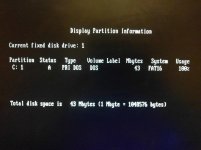PgrAm
Experienced Member
Hi everyone,
Today I tried hooking up my 40MB Seagate ST-157a from my AST 286 up to my modern Win10 PC to copy over some files. To my surprise this worked just fine, windows recognized the disk and was able to read and write to it. I reattached the drive to my 286 and everything was working well and I was able to play some new games I had copied over. I realized there were some files I forgot so I reconnected the drive to windows and copied the rest, this is when things went awry. When the disk was reconnected to my 286 it would not boot. I got the standard "NON SYSTEM DISK OR ERROR". The disk will read in windows and in dos when booting from the floppy but it simply will not boot.
At this point I have tried reformatting the disk, reinstalling DOS onto it but still nothing. Anyone know whats going on with the disk? is it dead? I don't care about the data on the disk its all just copies of stuff I have elsewhere however I would very much like to continue using it. Is there anything I can do to get it working again?
Today I tried hooking up my 40MB Seagate ST-157a from my AST 286 up to my modern Win10 PC to copy over some files. To my surprise this worked just fine, windows recognized the disk and was able to read and write to it. I reattached the drive to my 286 and everything was working well and I was able to play some new games I had copied over. I realized there were some files I forgot so I reconnected the drive to windows and copied the rest, this is when things went awry. When the disk was reconnected to my 286 it would not boot. I got the standard "NON SYSTEM DISK OR ERROR". The disk will read in windows and in dos when booting from the floppy but it simply will not boot.
At this point I have tried reformatting the disk, reinstalling DOS onto it but still nothing. Anyone know whats going on with the disk? is it dead? I don't care about the data on the disk its all just copies of stuff I have elsewhere however I would very much like to continue using it. Is there anything I can do to get it working again?

